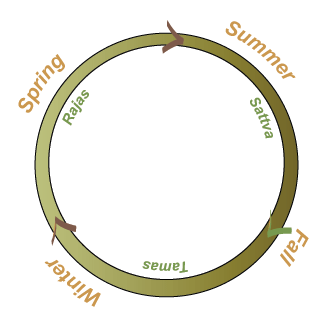Underpinning prakriti are three strings called “gunas.” These three strings combine in many ways to form the ropes of existence. The three gunas are tamas, rajas, and sattva. Tamas is passivity, inertia, heaviness, and dullness of existence. Tamas has been described as the cause of hunger, thirst, grief, fear, and confusion. Rajas is the opposite; it is activity, excitement, and passion. Rajas is the cause of lust, greed, and all desires – good and bad. In these two gunas, we find hints of the Daoist definitions of yin and yang. Sattva is neither. Sattva is wholesomeness, harmony, lucidity, and beauty. To the Daoist, sattva is the Dao.
These three gunas combine the way electrons, protons, and neutrons combine to form all matter in our universe. However, the gunas are more pervasive; not just our physical bodies, not just the earth and everything on it, but all of our thoughts, our personalities, our experiences, and our desires are manifestations of the gunas at play. Despite the numerous and complex ways in which the gunas can combine, they are still unconscious. Everything we see is “just the gunas acting on the gunas,” and nothing more, according to Richard Freeman. [1]

Often students of yoga will confuse the role of the gunas and believe that sattva is the good gune, rajas is an okay gune, and tamas is the bad gune. Just as yin and yang are neither good nor bad, there are no attributes of good or bad inherent in the gunas. They are all part of prakriti, and the objective of Classical Yoga and Samkhya practice is to become free of prakriti completely – free even from sattvic states of being. Sattva can be harmful if you become attached to it and stop striving for freedom. Tamas can help release the attachment to sattva. Rajas can be good if you have become too tamasic.
The three gunas actually flow in a cycle: sattva replaces rajas, raja destroys tamas, and tamas develops out of sattva. We can see this flow every day. In the morning we are lying in bed not wanting to get up – tamas is predominant. We need desire, rajas, to motivate us and give us the energy to get going. We seek rajas in that morning cup of coffee or that lovely, sweaty Ashtanga practice. By evening, after a full day’s work, we sit at night, a cup of herbal tea in hand, and relax with a good book. Rajas has ripened into a sattvic state of mind. But once the tea has been consumed and the favorite book has been read, our minds turn back to the tamas gune. We are ready for the oblivion of sleep once again.
The three gunas are constantly in flux; like the game of rock, paper, scissors – as soon as one gets on top, the next one comes along and changes everything again. The cycle may turn quickly or it may take eons, but we know nothing lasts and everything changes. This is the nature of prakriti.
What still is unclear is how the three gunas manifest. How does everything that we see around us, that we experience within us, come to be? To answer this we need to look deeper into the model of Samkhya
